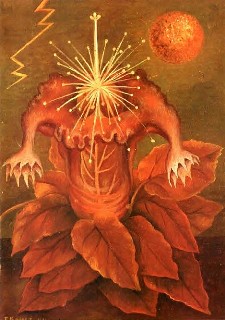Flower
of Life
(Flame Flower)
1943
Frida saw flowers as a symbol of sexuality and feelings. She would often project her sexuality onto her paintings. Sometimes the sexual innuendos are subtle and not so obvious, as in her earlier painting "Fruits of the Earth - 1938", and other times they are the main focus as in this painting. Here she paints an inverted mandrake plant in the form of male and female sex organs. As the sun in the background generates life, sperm shoots from the phallic stamen and vagina-like leaves form the petaled womb that protects the growing fetus.
Although this painting is dated 1944, it was actually painted in 1943. Its original title was "Flame Flower".
This painting was exhibited at the "First Salon of the Flower" organized by the Secretaria de Agricultura y Fomento (1943).

Oil
on masonite
10 7/8" x 7 3/4"
Dolores Olmedo Patiño Museum
Mexico City, Mexico
Óleo sobre fibra dura
27,8 x 19,7
cm.
Museo Dolores
Olmedo Patiño
Ciudad de México, México
Flor de la vida
(Flor de llama)
1943
Frida consideraba a las flores como un símbolo de sexualidad y sentimientos. Tambien a menudo ella proyectaría su sensualidad en sus pinturas. Algunas veces, las insinuaciones sexuales son sutiles y no tan obvias, como en su pintura anterior "Frutos de la tierra - 1938" y otras veces son el principal foco, como en esta pinturas. Aquí, ella pinta una mandrágora invertida con la forma de los órganos sexuales femeninos y masculinos. De la misma manera que el sol en el fondo genera vida, esperma brota de los estambres fálicos y las hojas con forma de vagina forman la matriz de pétalos que protege el feto en desarrollo.
Aunque esta pintura esta fechada 1944, fue actualmente pintada en 1943. Su título original era "Flor de llama"
Este cuadro se exhibió en el "Primer Salón de la Flor", organizado por la Secretaría de Agricultura y Fomento (1943).